Review: Cards of Cthulhu (DVG)
Posted by Denny Koch on August 12, 2014
Publisher: DVG
Published in: 2014
Designer: Ian Richards
Era and Topic: Contemporary / Hypothetical / Cthulhu Myth
Components: 8 Investigator cards, 8 Follower cards, 10 Item cards, 8 Cult Gate cards, 4 Minor Horror Cult cards, 4 Major Horror Cult cards, 4 Unspeakable Horror Cult cards, 60 Minion Cult cards, 7 Custom Cthulhu Dice, 4 8.5″ x 11″ Cult (player) boards, 10 Metal Custom Cthulhu Coins, 1 player help sheet
Game Type: cooperative card game (1-4 players)
HFC Game-O-Meter: E
Our Rating (1-10):
Graphic Presentation: 8
Rules: 8
Playability: 7
Replay Value: 6.5
Overall Rating: 7
| PRO | Cthulhu! Can be played as a solitaire game or cooperatively. Great artwork. Very simple and fast game for the Cthulhu quick bite. Fast game play, almost no setup time. |
| CONTRA | Very high random element: game can be unbeatable or a stroll in the park. Very simple mechanics without surprising elements (like special events). Not all required information are printed on the cards, which unnecessarily forces the players to refer to the rule book during a game. All cults have the same cultist types, which appears somewhat generic. |
Introduction
Ia! Ia! Cthulhu Fthagn!
As we already mentioned in our Hornet Leader – The Cthulhu Conflict review, we are Cultists. We are avid fans of Cthulhu and the other Great Old Ones, so we love playing games about the Cthulhu myth. It’s always interesting to see how a game approaches the topic and how it deals with the signature features of this universe: Great Old Ones, gates, minions, cultists, investigators. There is a vast plethora of Cthulhu games on the market, monster games like Arkham Horror, quick and fast games like Elder Sign, or the Call of Cthulhu LGC.
So – when we played the new “Cards of Cthulhu” game in our HFC Test Lab, the most interesting question about “Cards of Cthulhu” was: is the game bringing any new angle or unique feature to the topic?
Why do we need another Cthulhu game and what sets the game apart from the other games?
Cards of Cthulhu is a quick, very simple game. It can be played as a Solitaire game as well as with 2-4 players who play the game cooperatively vs. the paper AI. Both options work without any adjustments to the rules. Each player assumes the role of an Investigator. The goal of the game is to fight 4 cults whose cultists try to awake a Great Old One by opening gates and raising minor, major and unspeakable Horrors. The time limit is set by the card deck; if the cultists don’t manage to overrun the world before the deck runs out, the players win.
The game was designed by first-time designer Ian Richardson and published by Dan Verssen Games (DVG). It was a Kickstarter game where all stretch goals had been reached by the backers, so the game offers some nice bonus features like mounted boards and metal coins.
Game components and graphic presentation
The game is shipped in a sturdy, solid box with cool Cthulhu artwork on the cover.
The box contains 10 Investigator cards, among which players choose their character. The other cards are shuffled into one large deck, containing all types of playing cards like Cultists, gates, Minions, items, Followers. The cards are of a good printing quality, but appear to be somewhat thin. Since we sleeve all our card games, this wasn’t a problem at all.
Generally, the illustrations on the cards are quite thematic and true to the topic. What we didn’t understand, though, was the simple fact why the Investigators and the Followers have the same illustrations. We know that each character is meant to be a “generic archetype” and not “Susan Miller, the journalist”, so that’s the explanation why each character can appear as an Investigator as well as a Follower. So you can “be” the Priest and at the same time recruit the Follower “Priest”. But to us, it would have been more atmospheric if each Investigator was a unique character with a unique picture. Playing a character and then getting the exact copy with the same illustration as a Follower simply felt awkward.
In addition, there are 4 mounted cult boards, representing one cult each (the Cults of Cthulhu, Arwassa, Chaugnar Faugn, and Yog-Sothoth, respectively). During our first game, the boards warped heavily and tended to turn around on the table when we touched them, but the warping was entirely gone when we unpacked the game for the second time. Since then, the boards remained plain and didn’t warp at all anymore.
There is also a Help Sheet which offers quick rules reference for the players. We always appreciate help sheets, regardless of how simple a game is (and Cards of Cthulhu is certainly one of the easiest Cthulhu games out there) – it serves as a rules reminder and is especially helpful when you didn’t play a game for a while and want to return it to the table without re-reading the entire rule book.
The game contains three types of special dice, Health dice, Body dice, and Spirit dice. These dice are used for combat resolution. The black dice are nicely done, but one of our players had slight problems in distinguishing some of the numbers, which are printed next to a colored tentacle-shaped object. Other players didn’t have any issues at all, so this doesn’t appear to be a general problem.
The currency within the game is “Experience” which is represented by golden metal coins. These were added as a Kickstarter stretching goal and we thought them to be really cool. Pure cosmetics, but much more evocative than counters.
Besides the full-color rule book, the game also contains an artwork book, which illustrates the origination process of many illustrations with comments and explanations by Cloud Quinot, the artist (who also did the artworks for Hornet Leader – The Cthulhu Conflict).
The overall production quality is, as usual with games published by DVG, very good. Especially the artworks are very atmospheric and true to the topic with painting-like illustrations. As in Cthulhu Conflict, the artist did a great job to convey a very special, very dark Lovecraftian atmosphere.
There is also a “Cards of Cthulhu Bonus pack” available which includes 7 more Cthulhu dice and 10 more coins. This is helpful if you play the game with more players, so players won’t have to share the dice – and you can never have enough coins. But the Bonus pack doesn’t include any additional cards, or rules, it isn’t a game expansion! So whether additional dice and coins are important enough for you to buy this expansion, is a matter of personal preference (you could also share your dice among all players and use coins of your local currency).
Rules
The 24-pages-full color rule book is very comprehensible with lots of illustrations, examples, and short, clear instructions. Only the first 15 pages are rules, though. After the rules section, you will find a sample game, and several Cthulhu short stories by renowned professional authors (you can download the rulebook here on the official DVG website).
The game is pretty straightforward and the rule book does a very good job in describing the components and game play elements. Since the game is really easy and fast, the rules are grasped within minutes. There are no black holes or contradictions in the rule book, after one read-through, you can jump into the game immediately without ever referring back to the rules.
With one exception, which was – in our opinion – an unnecessary complication to an otherwise hassle-free game, which will be detailed in the following “Playability” section.
The timing of abilities (by Investigators, Followers or Items) raises some questions among players in the forums, but if you stick to the wording of the rules as close as possible, most questions can be resolved. You should abstain from interpreting something in the rules that isn’t written there. For example, during a multiplayer game, players are allowed to “borrow” their Followers‘ and Items’ special abilities to other players (as long as it wasn’t a “once per turn” ability they used for themselves during their own turn). This will make some Followers quite strong and important to the team, like the Journalist Follower, who can use her ability several times during a turn, and thus also for all other players (there is no rule indicating otherwise). But Investigators’ skills can only be used during your own turn, which automatically excludes the opportunity to use it on another player. So despite the fact that the Thief as Investigator and the Thief as Follower have almost identical abilities, the Investigator can only use the ability on herself, while the Follower can be used by any player during the turn. This should be kept in mind when playing the game, so most questions will be resolved by sticking to this rule. Whether this may be logical (for example, with the doctor who can only “heal” himself because he has to use his ability during his own combat phase), isn’t of interest here, so don’t let yourself become confused by thinking about it. This isn’t a simulation, after all, but a quick card game.
There are no “Living Rules” or anything like that. The rules are finished and no changes or errata are to be expected. The game can be played “offline” out of the box wherever you are (even in a cabin deep in the woods). In fact, it’s a perfect travel companion.
Gameplay and Playability
Generally, as mentioned before, this is a very simple game, perhaps the simplest Cthulhu game out there.
This doesn’t mean that the game is easily beaten! The Cults provide a challenge and may beat you in the blink of an eye.
But the rules and gameplay mechanics are really easy and learned within minutes. You can explain the game to anyone, even inexperienced or young players, and they will grasp the mechanics in no time. This game obviously doesn’t want to be a complex Cthulhu simulation, it wants to be a fast and furious card game in a Cthulhu setting. Perfect for a break or during travels or for a quick match on a rainy afternoon while waiting for the sun to come out. A perfect in-between game when you have some time to fill, but don’t want to play something complicated or elaborated.
Set Up
One of the main charming aspects of the game is the fact that there is almost no set up time. You unbox the game, you start playing.
Game starts with each player choosing one Investigator and placing their Starting Experience (i.e. coin) next to their character. All surplus Investigators are placed aside, the other cards are shuffled into one “Cult Deck”. Place the four cult boards on the table, and that’s it – no more setup. You jump into the game immediately by deciding which player goes first.
The Turn Order is quite simple. All steps are repeated each turn for each player.
1. Summoning
The phasing player draws 4 cards from the Cult deck. It contains “evil” cards like cultist, Horrors, gates or cursed items, but also “good” cards like Followers and useful items.
Cultists and Gates are placed on their respective cult boards. Cultists and boards are color-coded, so you see where each cultist belongs to. Horrors are placed on the cult board as well but on their “sleeping” side; they “awake” when there are enough cultists with them on their board. For each board that contains one or more gates, one additional card is drawn each turn. This effect kicks in immediately, so if you draw your first gate, you immediately draw an additional card this drawing phase.
If you draw an Item or Follower, place them beside the boards.
2. Purchase Items and Followers
Now players can decide to purchase their just-drawn Items and Followers for their printed coin cost. If they decline to buy a card, they discard it and get one coin in return. Cursed items cannot be discarded, they have a condition which must be fulfilled in order to avoid a negative effect. The Cursed Scroll, for example, requires the player to pay 2 coins now or to draw 3 Cult cards. Cursed items are discarded as soon as their cost is paid or their effect triggered.
Followers are recruited by paying their printed purchase cost.
3. Awaken Horrors
Horrors now awake when they have enough cultists on their boards. Minor Horrors require 2 cultists, Major Horror 3 cultists and Unspeakable Horrors 4 cultists.
Horrors who are asleep are removed quite easily. Horrors who are awake are really dangerous, so you should always try to avoid their awakening (by removing as many cultists in a given turn as possible). If you draw three cultists during your draw phase and then a Major Horror, that’s a misfortune which cannot be avoided. Ignoring 4 cultists on one board during your turn and then drawing an unspeakable Horror during the next draw phase is your own fault.
Once a horror awakes, it is flipped to the Awaken side. The phasing player (only) must check whether he loses sanity. He must immediately discard as many Experience Coins as the Horror requires (2 for Minor, 3 for Major, 4 for Unspeakable). Alternatively, he can slay a Follower and discard him or her. If the player cannot pay the cost and doesn’t have a Follower to slay, he goes insane and is out of the game!
4. Combat
During the Combat Phase, the phasing player can conduct actions in any order he wishes.
Combat:
He can choose to make 1 attack. First, he must designate which of the 4 combat boards he wants to attack as the “Target Cult Board” (only the Explorer can roll first and designate his target later).
The player always has one Body Die (red) and two Health Dice (green). In addition, he can choose to buy up to 3 additional Spirit dice by spending Experience coins. If he owns the item “Sword of the Crusader”, he can use one additional spirit die for free once a turn.
After seeing the results, the player can re-roll all dice that didn’t show a “1” (only the Priest can re-coll Health or Spirit dice showing a “1”).
A “1” is a bad number in this game; if the 1 is on the red Body die, this represents a hit or mistake during combat, and the player loses one of his Health die or must slay a Follower. The Health die can later be repurchased by spending 3 experience coins. If both Health dice are lost, and the player gets another hit, he is dead and out of the game.
Minions are protected by Awake Horrors, so you have to slay all Awake Horrors before you can target a minion. Minions protect sleeping Horrors and gates.
Each Minion on the target board has a Health number printed on its card. You have to roll a number equal to or higher this Health number to slay the Minion. Since you roll several dice, you can slay several Minions at once. This is where a “Card of Cthulhu” special mechanics comes into place and where the real fun is. It isn’t enough to count the eyes on your rolled dice. For example, if there are two Minions on the cult board, one with a Health of “6” and one with a Health of “3”, it’s not enough to roll 9 eyes. You have to physically place dice on the Minion card, so if you rolled a 5 and a 4, you must decide whether you place both dice on the “6” Minion or the 5 or 4 dice on the “3” Minion – you cannot kill them both with such a roll, regardless of the fact that you (mathematically) rolled enough eyes to kill them both.
In fact, allocating your rolled dice to the various targets on the board can be quite tricky and requires decision-making and tactics. You have to be on the guard where you place which die, and where you place which combination of dice because it’s often possible to match the Health numbers of a Minion with various dice combinations. You always have to figure out how to make the maximum impact with your results without wasting eyes on your dice. This is a simple but quite elegant design which we greatly enjoyed. Combined with the possible re-rolls and certain special abilities of your Investigators, combat resolution is the central focus of the game.
For each Minion you slay, you gain one Experience.
Sleeping Horrors are easily removed; you just have to allocate a certain number of dice to the Horror card (2 for Minors, 3 for Majors, 4 for Unspeakables), regardless of the numbers of rolled.
Awake Horrors are more difficult. Each Horror type has a “Combo Value“. In order to slay them, you have to place a dice Combo on their cards – either pairs (“Matching combo”) or two or more dice in sequential order (“Running Combos”). A Minor Horror needs a 2-Combo, a Major a 3-Combo and an Unspeakable a 4-combo. For example, if you want to remove an Unspeakable Horror, you have to roll 4 dice showing the same number (for example 5,5,5,5), or 4 dice with in sequential order (1,2,3,4). But that’s not all – Awake Horrors bite back! While you suffer a hit against a minion only when your body die shows a “1”, you will suffer a wound from a Horror for each number equal to or lower than their Combo number. So an Unspeakable Horror will wound you when your Body die shows a 1, 2, 3 or 4!
The reward for slaying a Horror is great, though. Regardless of whether the Horror was awake or sleeping, you will get Experience equal to their combat value for slaying them. So slaying them early while they are still asleep is the easiest way to accumulate coins.
Closing Gates
During the Combat Phase, you could also choose to close gates (as long as there are no Minions left to protect them). This is done by purchasing the “Seal Gate Magic Spell” by discarding 3 Experience. Since you will also gain 1 Experience for destroying a gate, the net cost of 2 Experience is reasonable.
Using Items, Magic, and Abilities
During the Combat Step, you could also use other Magic Spells: Healing, which costs 3 Experience and brings back one lost Health die, and, which is very important, the “Hurry Spell” which allows you one follow-up attack on any board (cost 2 Experience). Often you cannot clear a board with one combat roll, or you have to clear a second board in order to prevent a catastrophe in the next turn, so a second attack is often vital.
Some Investigators have special abilities that could be used now during their Combat turn.
You could also use Items you purchased, for example the “Necronomicon” which allows to close gates, even protected ones, or the “Temple of Light” which allows you to discard 2 Cult cards each turn in order to “burn” the deck faster.
5. Outcome
When the Combat Phase is over, you check the Outcome: check for Victory or Failure.
Players win the game when the Cult deck is out of cards and there are 4 or fewer Minions and no awake Horrors on any cult boards.
Players lose the game if any cult board has 5 or more Minion cards.
Then the game commences with the next player who repeats steps 1-5.
Playabilty
Gameplay is fast and not complicated, the length of a game is more depending on social interaction between the players and debates regarding what to do in a given situation, so a session can last between 20 minutes and a maximum of 2 hours.
The rules do a good job do support the “fast and simple approach” because they are written in a clear and comprehensible fashion.
There is only one BUT and this is an entirely unnecessary complication to the elegant and quick gameplay. It doesn’t make the game more difficult or anything. It simply draws time which prevents the game from being played even faster than it already is:
Unfortunately, there is some vital information about several cards only detailed in the rule book. Most of the cards are self-explanatory, but some cards have certain conditions when and how often they can be played during a turn.
These instructions could have been easily printed on the playing cards. In fact, it would have been extremely helpful to add the short description to the cards instead of hiding them in the rule book. So when playing, you are forced to refer to the rules, which slows down game play and is unnecessary – because the peculiar charm of the game is the fact that it is so simple that you don’t have to refer to the rules ever again during the course of the game.
Examples are the Follower cards – some of the Follower’s special abilities can only be triggered “once each turn” (for example, the Big Game Hunter), others can be used as often as required (the Journalist). Since there is enough space on the Follower’s cards, we would have preferred that the instruction texts, which are now listed in the rule book, would have been printed on the cards instead. The “abbreviated” texts on the cards are often misleading, especially to new and inexperienced players or to players who never refer to the rule book when playing a card.
The text on the “Big Game Hunter” Card is even somewhat problematic and could be interpreted differently from the description in the rule book. The card text says “Before suffering a Sanity Loss, discard any Horror”, while the description in the rule book says: “Once each turn during the Awaken Horror step, you can pay 3 Experience to discard any one Horror. This Horror can be awake, asleep or even be protected”. The card text suggests that the ability can only be used immediately before suffering a Sanity Loss, while the rule book suggests that the ability can be used once per turn, regardless of the requirement of making a Sanity check. Restricting the Big Game Hunter’s (alreadys expensive) ability to the rare occasions when he would suffer a Sanity Loss would seriously impact his usefulness.
The same is true for Items, which also have certain playing restrictions. The text on the Necronomicon card, for example, says: “Discard any Gate”. The rule book explanation for the card says: “Once each turn, you may pay 2 coins to discard any Gate in play, even if the Cult board has minions”. You are prone to mis-using this card by closing as many gates during a given turn as you wish (and can afford, because you have to pay Experience to use it).
After a while, you will certainly know each condition by heart, but this is especially hindering for new players you just introduced to the game by explaining it to them. They play a card (like a Follower or Item), and you have to remind them: “Nope, this can only be played once during a turn”, or “why didn’t you play this card, you can use it as often as you like”.
In our opinion, a more precise wording on the cards would have improved playability and supported the design intended smooth and fast gameplay.
The game has a very high random element because everything is drawn from one common deck. There are no other decks, special event cards, or anything that could influence the game from the outside. On the one hand, this is pretty straightforward, you always know what to expect. On the other hand, this may lead to the awkward situation that one game is so easy it resembles a stroll in the park, while the next one is so difficult that it is unbeatable and will smash you within half an hour.
During our first game, we encountered the “stroll in the park” situation. We played with two players (the Doctor and the Priest), and we had complete control over all 4 cults all the time. After each turn, there were never ever any Minions, gates, or horrors left on any board. We drowned in coins, and had enough Followers and Items to rule the world. Not a single Horror awoke during the entire game (!) and we didn’t have to take a Sanity check once. After a while we began to wonder whether we got anything wrong or misinterpreted a rule. But we re-read and discussed the rules and didn’t find any mistakes on our side. The game was incredibly easy to beat and even got boring because we were in absolute control, there were no nail-biting decisions to be made. And we are of the strong opinion that in a Cthulhu game, the cults should be a serious challenge and the Great Old Ones should be so strong that beating them is always challenging.
After this first game, we were quite underwhelmed because we didn’t feel threatened or challenged, and it simply didn’t feel like a Cthulhu game. It was as if we were fighting poodles instead of Byakees and Deep Old Ones.
But since we don’t give up easily, we gave the game another chance. We know many DVG games and we never before encountered one that we didn’t like. Most of them offer incredible tough challenges, like Rise of the Zombies or the Leader series, but of course there’s still the chance to win the game. So we trusted in Dan Verssen’s judgement and thought that there must be something to the game which we were missing, otherwise he wouldn’t have published it. We also studied the forums and wondered about threads like “Has anyone ever beaten the game?”.
In our second game, we chose the Thief and the Tycoon as Investigators. This game was much more interesting than the first one. Much happened on the cult boards, we had to plan our turns very carefully and resource management became a vital aspect. We had to calculate with our coins because there was so much to do that we had to prioritize and to cooperate. Some times, we were close to being hacked to pieces by the cults and only escaped by the proverbial hair’s breadth. Especially gates began to become a real threat. During the combat step, you can conduct your actions in any order you wish, but we learned that keeping an eye on the order of when to conduct which action is very important. A mistake or “sucker move” during your turn can easily bring mayhem down on you and your team. And we learned that there is the possibility to do really bad moves during your turn, something, we didn’t experience during our first game.
We also learned that the different Investigators are more helpful or less helpful. The Tycoon is very helpful in the beginning because he brings more coin into the game. The Priest is helpful during the entire game because he allows for re-rolls of bad dice you could otherwise never re-roll. The Thief can be useful or completely useless, depending on when which item appears (she has the special ability of buying expensive items with less coin, but when there are no expensive items during your turn, or you don’t have enough coin when they appear, you can’t use your ability a single time during the game). So by choosing the right Investigators or a good coop-supporting combination, you can make the game easier or more difficult. We thought the Big Game Hunter to be somewhat strange, besides the fact that his text on the card is misleading. His ability is quite expensive (3 coins), can only be used once per turn, and cannot be used very often, so we didn’t get the point of why we should choose him over more useful characters who can use their ability permanently at no or much lower cost.
We played several more games, trying all Investigators and combining them into new teams. The more games we played, the more we liked the game. We liked the fact that there is almost no setup time and that the difficulty of the game isn’t in the rules but in decision-making. The Investigators felt different and some fit better to your personal playing style than others or fulfill different roles, like the Ritualist, who is a typical crowd-control character. Items like the “Temple of Light” are typical deck-control cards. Certainly the most important item in the game, the “Crusader Sword” (which gives you an additional Spirit die), is only useful when it comes early in the game (and when it can be afforded because it is the most expensive item).
With each game, we discovered more options or tactics and learned to deal with “peaks” when several boards were overrun by cults at the same time.
Something we wondered about was the fact that each Cult has the same types of cultists. This isn’t relevant for game play, but it’s a missed chance for delving deeper into the Lovecraft universe. All Great Ones are followed by Deep Ones, or Leng Spiders. We would have preferred if each cult had its own individual Minions which fit better to the specific cult. This appears somewhat generic and a card game should make the most of the fact that cards are there to bring flavor and variety to the table.
Replay Value
The replayability depends on what you expect from the game. Since the game has a very high random element which heavily impacts the difficulty and general game play, there is no “just another try, I will beat the game next time” feeling – your next time could be a cakewalk.
The main reason for taking this game from the shelf is the fact that it is a nice, fast, easy, quick card game with the bonus of providing a Cthulhu setting.
Whenever you have a little bit of time to fill, or you need a game that is easy and fun without any complications, which can be taught within minutes, or you need a game when you are abroad with friends or family and have to spend some time with a simple and cool game (instead of playing Yahtzee, Uno or any card game with a regular card deck), this game is a perfect choice.
It’s certainly the wrong game if you expect a complex game deeply rooted in the Cthulhu myth, or if you want to use it to delve deep into the Lovecraft universe. This will not be the reason why you take this game from the shelf – here you should take a look at the more “meatier” games like Arkham Horror, or the Call of Cthulhu LCG.
As a typical fast “filler-game”, the replay value is certainly high because you always need a filler game in your collection – and the Cthulhu setting comes as a bonus!
Creativity
So what is the unique characteristic of this game that distinguishes it from all the other Cthulhu games out there?
It’s certainly the combination of simplicity combined with the Cthulhu setting. As we mentioned before, this is probably the easiest Cthulhu-themed game out there. Despite of the simplicity of the rules, the game requires thinking and decision making.
The game play is much too simple to be regarded as “highly innovative”, but the game doesn’t want to be a revolution. The core mechanics of allocating dice to targets isn’t new (a similar combat resolution is used in FFG’s Elder Sign, for example), but combined with the elegant mechanic of combining health, combat results, and spirit all into the three different types of dice, it makes for a fresh experience.
Simulation Value
This game certainly isn’t meant as a simulation.
The question is: Since the game is placed in a Lovecraft universe, how well does it “simulate” this world, compared to other Cthulhu games?
The atmosphere conveyed is certainly dark and “Lovecraftian”, mainly due to the great artworks, especially of the Minions and Horrors. A missed opportunity was the fact that each cult uses the same minions instead of individual minions which are more closely associated with the respective cult.
Since sometimes the game can be beaten really easily, there isn’t always the tough challenge expected from a Cthulhu game. Other games are extremely threatening with constant pressure on the players.
All in all, the game does a good job in representing the Lovecraft universe, but could have done better in providing more love for detail in order to satisfy the initiated fans.
It is Cthulhu-themed, but not too Cthulhu specific, it could easily be placed in a different universe (for example, Warhammer 40k) by exchanging the names and art.
Solitaire Playability
The game can be played by 1 – 4 players, so the Solitaire Playability is perfect. The rules are written for Solitaire play with a number of special options for cooperative play at the end of the rule book. There are no adjustments to be done, though, only clarifications on who may use which card when while playing with more players.
Can be Compared to…
…other Cthulhu games, of course. Cards of Cthulhu plays in a different league than all other Cthulhu games we know. Cthulhu games tend to be difficult, dangerous, and challenging, and many are richly detailed and offer much chrome to represent the different aspects of the Lovecraftian universe.
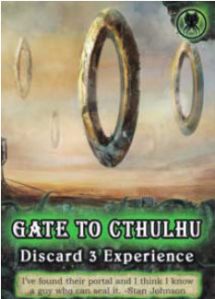
Gates should be closed as fast as possible because they could draw more Minions and Horrors into our dimension
Cards of Cthulhu, on the other hand, is a “Cthulhu light” game, which is first and foremost a fast card game with quick and simple, but nevertheless demanding game play.
So it’s not fair to compare this game to Arkham Horror for example, which became (with all the expansions you can use with the base game) a real monster game, it doesn’t want to compete with this deep and complex Cthulhu experience.
Naturally, due to its card mechanics, the Call of Cthulhu LCG (Living card game) comes to mind. But the CoC LCG is a Living card game, centered around building your own deck, and definitely more complex. It also requires more time and dedication, and isn’t as easily explained and played like Cards of Cthulhu. Both games cater to different audiences and while the CoC LCG is (naturally) closer to the Lovecraftian topic, it’s not meant to be played “on the fly” or as a filler game.
Elder Sign by FFG is one of the simpler Lovecraft games, but it’s nevertheless more complex than Cards of Cthulhu. The mechanics of allocating dice is similar, but differs enough to create an entirely different game with a different approach. It also offers much more detail and chrome.
As a matter of fact, Call of Cthulhu cannot be compared to other Lovecraft games we know because it’s aspirations are different. It’s a card game in the first place and a Cthulhu game in the second place, while all other games are first and for all meant to represent the Cthulhu universe (even sacrificing playability in order to reach this goal, like Arkham Horror, which can be so large that it takes a long time to set up, even endless hours to finish it, and so difficult that it’s almost unbeatable, especially when using expansions).
Denny Koch’s Conclusions
![]()
It’s difficult to recommend “Cards of Cthulhu” – it’s definitely a good game, but it’s also a very special game. It strongly depends on what you expect from the game and how and when you want to play it.
If you accept it as a quick, fun, light, simple card game which – as a bonus – is set in the Cthulhu universe, you have come to the right place. Especially if you are looking for a game which is easy to teach, playable alone as well as cooperatively, and even suited for inexperienced players, you should take a closer look.
If you expect a die-hard Cthulhu game which is full of lore and very true to the topic, you should look elsewhere. Lore isn’t what the game is about. It’s a card game with a Cthulhu bonus and this works fine – the rules are very good, supporting the simple approach, by being clear and comprehensible.
The flaws we described before are not critical or even impair game play. There are no black holes in the rules, no ambiguities (besides the Big Game Hunter), or other things that hamper a smooth and fast game play. It’s merely bothering during a game that you have to check the items and Follower descriptions in the rule book (which could otherwise easily remain in the box because the rules are so clear and the player aid card provides all required information). Clearer cards with more text would have been great.
The other points of criticism are cosmetic – personally, I thought it a pity that the Minions where of such a generic nature that each cult has the same minion cards. The same is true for the Investigator / Follower cards where it would have been much nicer if both had different illustrations. More individuality would have improved the atmosphere of the game without complicating game play.
One point is somewhat problematic, though, and that’s the fact that the course of the game is unpredictable. It’s good that the game has a high random factor, but it is a bit extreme that one game could be a stroll in the park without any peaks or even a minor threat, while others are almost unbeatable from the first minute. We are okay with that because we don’t give up easily, but I can imagine that this could prove problematic when you introduce new players to the game.
We, for example, have a friend who we often introduce to new games. Once a year he comes to our place and wants to see the new games we added since his last visit. He prefers fast, easy games which can be explained to him without the need of reading the rules, so Cards of Cthulhu would be a perfect candidate. But he is also quite critical and easily bored, so when his first game was similar to our first game when virtually nothing happened until the deck ran out, he would say: “well, nice game, any other new games?” without giving it a second chance.
This is somewhat dangerous, so perhaps it would have been better if the game mechanics included a fail-safe or fall-back which balances the course of a game (for example with Event cards which provide both positive or negative surprises). The game entirely depends on how many Minions and Horrors you draw per cult board, and can go south really fast when you draw several minions followed by a Horror. On the other hand, if the Minions are distributed one after the other and spread out over several cult boards, without gates, without awake Horrors (remember, not one awoke during our first game!), the game can even be close to boring, especially when playing with “stronger” Investigators like the Ritualist who can control the number of minions on a board. There are no unforeseen events or twists and turns in this game, all variety comes from different numbers and the random element of who spawns where. This, in our opinion, is somewhat dangerous in turning players off without giving the game a second chance. Other players complain that they never won a game so far. In our experience, we won approximately 4 out of 5 games.
And we had really thrilling games which were close to the edge all the time, and a constant struggle for keeping control! When the game is thus balanced, it really shines and requires decision-making, team-work, cooperation, and a keen eye on your dice results. Mistakes or “sucker moves” can prove fatal, for example when wasting dice by allocating them in a stupid fashion while you could have easily cleared the entire board with them. So the game can be really fun and a tough challenge – but sometimes, this doesn’t work because nothing controls the random element of the draw deck. If you encounter a game which seems oddly unchallenging and too easy, give it a another try and try out a different combination of Investigators. Some are more useful, some are almost useless, depending on the flow of the game.
All in all, we like Cards of Cthulhu – and our affection grew with each game we played. After our first game, we were underwhelmed and full of doubt because nothing happened and we just cleared the board, drew cards – game solved. But with each game, we discovered the hidden subtleties and the elegance of the gaming system – the tough decision making which is centered around allocating the dice, and the three types of dice which serve several game play purposes.
Especially the quick set up and game play, easy mechanics combined with the Cthulhu topic and the great artworks, grant the game a special place in the “filler games” section of our games collection.
Our Rating (1-10):
Graphic Presentation: 8
Rules: 8
Playability: 7
Replay Value: 6.5
Overall Rating: 7



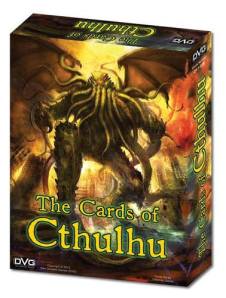
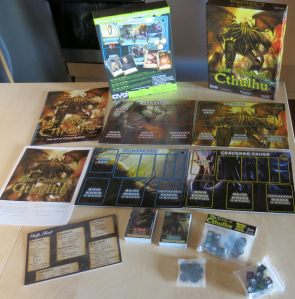
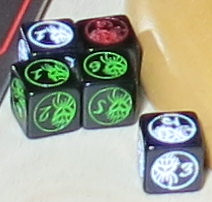
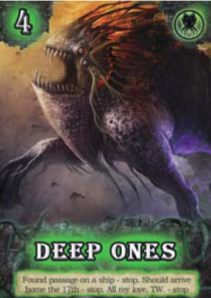
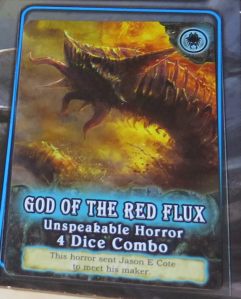
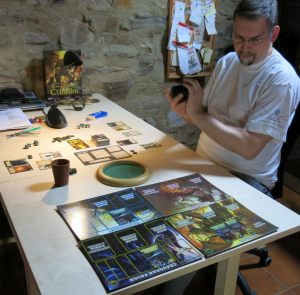
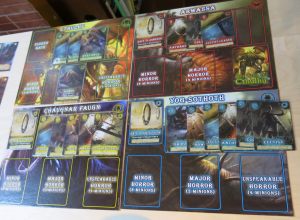
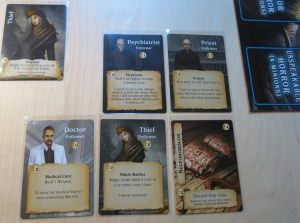
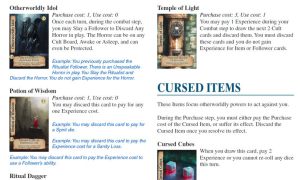
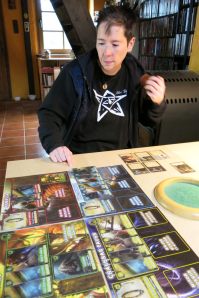
Scoops said
This is a fair critique of the game, well done! I really like this game for many of the reasons you describe – the zero set up time and fast gameplay really shine when you want to catch a quick game of something. I have only played this solo and have yet to win a game. The random nature is a blessing and a curse for sure – I have been going well only to have a single draw of cards finish me off in one go. Having said that, I am not sure what mechanism DVG could have used to rectify this without it interfering with the flow of the game. The artwork is great and the theme obviously helps keep you interested.
I hadn’t really considered about the text on the cards but you are right, they could have added the item’s texts to the cards rather than keep everything in the manual and the discrepancies that already exist between the two definitely need to be rectified.
In the UK this game isn’t that easy to get hold of but I bought it for £27 which makes it good value in my opinion. I look forward to the expansion coming in 2016 as I think there are definitely gameplay elements which could be changed to expand the overall experience. The worst thing about the game is help card which is poorly formatted and doesn’t match the standard for the rest of the game but then if that is the only thing to complain about then that is a good thing! Overall though, I think this is a fun game that is easy and quick to play, definitely one for the solo gamer out there!